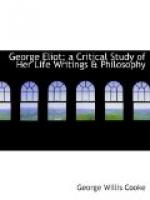Within her own lines of power George Eliot is much greater than Scott, who could not have written Adam Bede or Middlemarch, or brought out what is best in those works. Adventure was necessary to Scott; he could not have transfigured the plain and homely with beauty as George Eliot has done. Where she is at her best, as in the simple scenes of Silas Marner, there is a charm, pathos and sympathy in her work which must endear it to all hearts. That peculiar power Scott did not have; yet it would be most difficult to decide which is the truer to nature. Genuine art, it is true, has its foundation in the realities of human experience: but those realities are not always best interpreted by the methods of realism. In his own province Scott was truer to nature than George Eliot was in the same field, as may be seen at once by comparing The Spanish Gypsy with Ivanhoe, or any of Scott’s novels dealing with the mediaeval and feudal ages, he took the past into himself, caught its spirit, reflected it in its wholeness. In this he was a genuine realist, and all the more faithful to reality because he did not accept realism as a theory.
In comparing George Eliot with Dickens, it must first of all be noted that each is the superior of the other in his own special province. Dickens has more imagination; he appeals to more universal sentiments, touches a wider circle of experiences, captivates his readers with a resistless interest and tenderness of spirit. His characters are unreal, mere caricatures often, mere puppets. Yet he had an imagination of marvellous power, so that his characters appeared to his own mind as if real, and he describes them as if they actually stood before him, making them intensely real to his readers. Many of his persons never lived, never could have lived; yet they are types or certain traits of character made living and brought out into a distinctive existence. What those traits of character are he makes all the more apparent by this method.
Dickens had not a fine literary taste, he had no clear insight into some of the purer human sentiments, he was grossly untrue and false in many of his pictures. Yet all in all, with his many faults, it is to be said that his idealism, which was not of a high type, made him a true interpreter of life. If his characters are less faithfully drawn than George Eliot’s, his insight into some of the sentiments and emotions was truer. His pictures may be false in some particulars, but he has given them the true spirit with which they should be animated.




